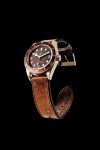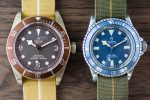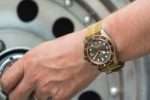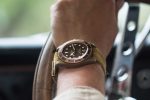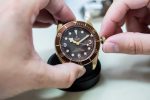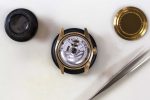Reviews
When Bronze Wins Gold
Reviews
When Bronze Wins Gold
Growing in popularity as a material for watchcases, the alloy has been used by Panerai, Oris, Bell & Ross, Ball, Hublot, Montblanc, Steinhart and a number of other houses. Part of the appeal is the material’s use throughout history in cases of marine chronometers, a whiff of nautical authenticity that permeates the timepiece. Looks, however, make bronze a real winner for those seeking a change from steel or gold: although bronze might seem like an impractical and unsuitable material for contemporary watchcase construction because it oxidises easily, it’s this attractive and unique patina created by the oxidisation that makes every piece unique and personal.
It’s another case of degradation that actually possesses its own charm for enthusiasts, like the aging of defective dials that are dubbed “tropical”. In this case, the oxidisation can be easily cleaned off, although layer of oxidisation, indeed, protects the underlying metal from further corrosion.
By doing nothing more than wearing it, every bronze watch will develop its own unique look, ranging in appearance from gold to black and even orange, pink, green or blue, acquiring a level of naturally-occurring customisation that money cannot buy. Best of all, the base metal is protected by this coating. If an owner finds the patina distasteful, the case can polish it back to its original state, causing future Antiques Roadshow experts to suffer palpitations in the process.
Beyond its individual ageing process, bronze has a special allure that transcends the ages. Its importance in human civilisation cannot be underestimated: around 3000BC, it moved us out of the Stone Age and it has been used ever since to represent wealth, status, culture and power. But the alloy really came into its own during the Renaissance, when it became a favourite material in the core of fine art: Italy.
Alloys are traditionally composed of copper and tin in varying proportions, but some modern bronzes contain no tin at all, substituting other metals such as aluminium, manganese or zinc in the blend. The results of creating alloy vary in important ways: where there is a high tin content, there is a greater sonorous quality leading it to be labelled “bell metal”; the addition of phosphorus, manganese or zinc increases the strength rendering it ideal for use in mechanical engineering; adding aluminium – as with many watch cases – leads to a strong and corrosion-resistant metal.
While the alloy could once have be dismissed as a popular novelty in horology, the fact that one of the watch industry’s biggest players has now joined the Bronze Age suggests that demand is, in fact, stronger than ever. Tudor’s Black Bay Bronze features a warm, honey-coloured 43mm case made of aluminium and bronze. For the first time, Tudor has also incorporated a chocolate-brown colour for the dial and unidirectional bezel, perfectly complimenting the bronze case. Together with the creamy luminous material and gold accents, the impression is that of a nicely aged “tropical” dial, but without the need for ageing nor of defective paint.
Beyond the “personality” of the Heritage Black Bay Bronze by virtue of its looks, another feature worthy of attention is that from 2016, Tudor has introduced in this model the company’s COSC-certified, in-house movement, which will feature across the Black Bay line-up — the “Mouvement Tudor” Calibre MT5601. Beating at 4Hz and featuring a variable-inertia oscillator with silicon balance spring, the movement provides 70 hours of power reserve.
Bronze? In this case, the GPHG “Petite Aiguille” victory makes it a precious metal.




